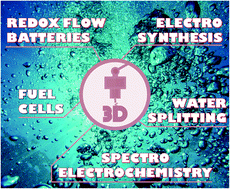3D-printing for electrolytic processes and electrochemical flow systems
Abstract
During the last few years, the use of additive manufacturing technologies, also known as 3D printing, has become increasingly popular in laboratories and research facilities. The reduced costs of printers and the large availability of different materials facilitate the adoption of this technology over established fabrication processes generally more costly and time-consuming. The use of 3D printing for the fabrication of electrochemical components is only at a very initial phase but has shown promising results in terms of research and developments of innovative and better performing devices for both energy and synthetic applications. However, a complete understanding of the benefits and limitations of the available 3D printing methods as well as a careful evaluation of the material properties is necessary to fully exploit this technology. A short description of the most commonly adopted 3D printing methods and principles is provided here as a useful foundation prior to the description of their most recent uses for electrochemical flow systems towards energy-related applications, electrosynthesis, water splitting and spectroelectrochemistry. A final discussion of possible future directions will be also given.

- This article is part of the themed collection: Journal of Materials Chemistry A Recent Review Articles


 Please wait while we load your content...
Please wait while we load your content...